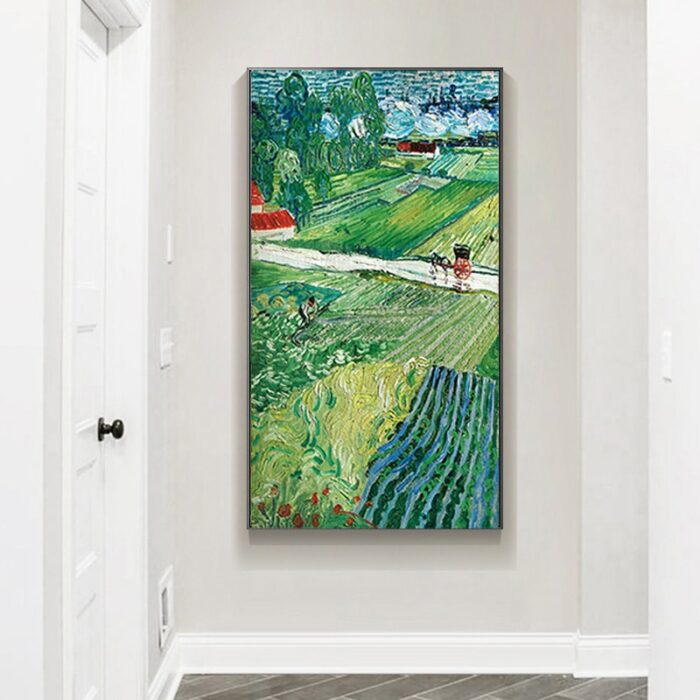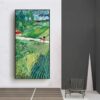Vincent van Gogh’s landscape paintings have left us with numberless questions when dying in 1890. He is often referred to as the ‘painter of the sunflowers’ – or otherwise as to the ‘mad artist‘. Today van Gogh is regarded as one of the most admired Post-Impressionist painters. Although he only sold one of his works during his lifetime, his work has been sold after his death for record numbers. The most expensive of van Gogh’s paintings was the portrait of doctor Paul Gachet, who took care of the artist in the final months of his life in the commune displayed in this picture of “Landscape with Carriage and Train”. Exploring Vincent van Gogh’s landscape paintings, his expressive and emotive use of vivid colour, and the brisk application of impastoed paint can give us some insight into the artist’s innermost thoughts.
Where is the picture “Landscape with Carriage and Train” today?
Vincent van Gogh’s paintingPainting is a fundamental form of visual art that has been practiced for thousands of years. It involves applying pigment to a surface such as canvas, paper, or a wall. Painting can be explored through various styles, techniques, and mediums, each offering unique possibilities for expression and creativity. Historical Background • Ancient Beginnings: The history of painting dates back to More “Landscape with a Carriage and a Train” is part of the collection of the Pushkin Museum of Fine Arts in Moscow.
What’s in it?
The landscape paintingLandscape painting focuses on the depiction of natural scenery such as mountains, valleys, trees, rivers, and forests. It has been a significant genre in art history, evolving through various styles and periods. Landscape painting captures the beauty of the natural world and often reflects the cultural and philosophical views of the time. JMW Turner, Calais Pier, 1801 Historical Context Landscape More by van Gogh displays a vast scenery in Auvers-Sur-Oise. The artist emphasizes high-rising grass in the foreground through long slashes of paint. The colours are applied in fiery brushstrokes with ridges of thick impasto typical for his late style. Van Gogh uses a viewpoint from above, showing the fields, the carriage, and the train – one of his favourite perspectives.
This all-encompassing view recalls van Gogh’s approach in the picture “The Harvest”. However, the palette in “Landscape with Carriage and Train” displays strongly muted tonesIn color theory, a tone is a version of a color created by adding gray (a mix of black and white) to the original hue. This concept is essential for artists and designers as it allows for a wide range of colors that are neither too dark nor too light, providing versatility in creating depth, mood, and harmony within a More, devoid of the hot yellows Vincent applied to express the warmth of the Provençal sunlight.
What’s the context?
Van Gogh Facts:
- “Landscape with a Carriage and a Train” is one of many pictures that van Gogh frantically created in only a few weeks before his death in the Summer of 1890.
- He had just left an asylum In Saint-Rémy, where he had been treated for mental health problems, traveling to a north-western outskirt of Paris, Auvers-Sur-Oise.
- In Auvers, he sought the care of homeopathic doctor Paul Gachet. Van Gogh finished a famous portrait of Gachet just before paintingPainting is a fundamental form of visual art that has been practiced for thousands of years. It involves applying pigment to a surface such as canvas, paper, or a wall. Painting can be explored through various styles, techniques, and mediums, each offering unique possibilities for expression and creativity. Historical Background • Ancient Beginnings: The history of painting dates back to More “Landscape with a Carriage and a Train”.
- In one of Vincent van Gogh’s letters to his mother and sister Wil, he declared to have become absorbed “in the immense plain against the hills, boundless as the sea, delicate yellow”, describing the placid fields as a perfect reflection of his calm mood.
- In another letter to his brother Theo, however, he admitted feeling very depressed: “There are vast fields of wheat under troubled skies, and I did not need to go out of my way to express sadness and extreme loneliness.”
Recommended Readings:
This article may contain compensated links. Please read Disclaimer for more info. As an Amazon Associate, I earn from qualifying purchases.
Ingo F. Walther et al. (2020): Van Gogh. The Complete Paintings
Vincent Van GoghVincent van Gogh (1853 – 1890) is one of the renowned Post-Impressionist artists, best known for his striking use of colour, emphatic brushwork, and contoured forms. As a son of a pastor, the Dutch artist war brought up in a religious and cultured atmosphere. After working unsuccessfully as a clerk at a bookstore, as a salesman, and as a preacher More (2020): The Letters of Vincent Van Gogh
Martin Gayford (2008): The Yellow House: Van Gogh, Gauguin, and Nine Turbulent Weeks in Provence
Steven Naifeh et al. (2012): Van Gogh: The Life (RANDOM HOUSE)
Steven Naifeh (2021): Van Gogh and the Artists He Loved













1 review for Landscape with Carriage and Train by Van Gogh – Canvas Giclée Print
There are no reviews yet.